Navigating the challenging process of managing restaurant reservations is a crucial aspect of running a successful business.
A disorganized management practice can spark chaos, leading to disgruntled customers, rampant no-shows, and inefficient use of resources.
Thankfully we’re here to help.
This article aims to give you seven actionable tips for handling guest bookings better.
Here, you'll discover strategies and practical suggestions to streamline your reservation process, improve customer experience, and secure your revenue.
With these tips in hand, you'll be well on your way to mastering the art of reservation management.
To kick things off, let's explain how an effective reservation system can simplify your operations.
Have a Single Reservation System in Place
When it comes to effectively managing restaurant bookings, consolidating everything into a single reservation system is often one of the most significant changes you can make.
Imagine the confusion when each of your employees has their unique way of handling reservations.
Some might rely on memory, others jot down booking details on sticky notes or scraps of paper, while others might even fill out a detailed reservation spreadsheet.This kind of incongruity opens the door to mistakes, duplicate reservations, and miscommunication between staff.
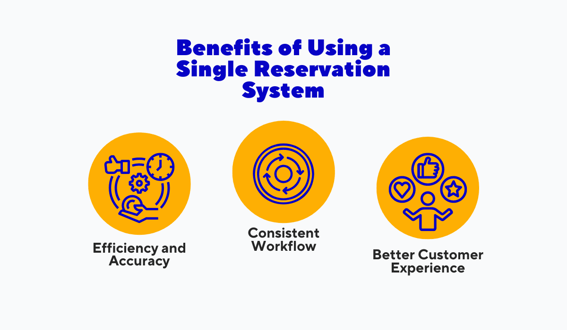
Source: Tablein
Whether you decide on a good old pen-and-paper system, or spreadsheets, or take a step into the future with an online reservation system, the result is the same—a more efficient and accurate reservation process and a consistent workflow for your staff.
And this efficiency benefits diners too, as your staff will make fewer mistakes that may cause your patrons frustration and hurt their customer experience at your eatery.
Now, if you really want to maximize these benefits, consider using an online restaurant reservation software like our very own Tablein.
It's a tool that's packed with a lot of useful features but still manages to be intuitive and user-friendly.
For example, take a look at the reservation management feature below.
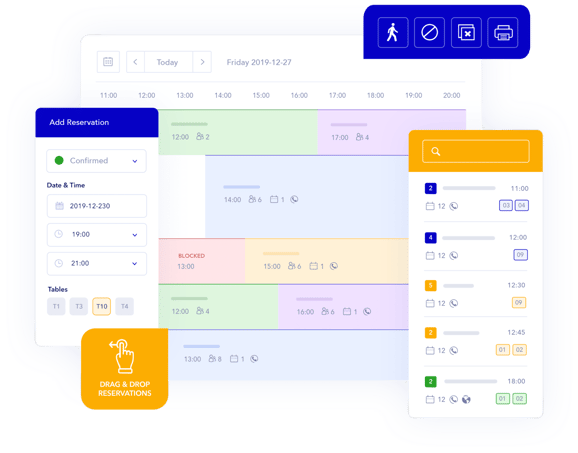
Source: Tablein
With just a few clicks, staff can view all reservations, add new ones, and manage everything effortlessly.
This level of simplicity and efficiency is what makes Tablein the go-to choice for many restaurateurs.
Just take a look at these stellar reviews of the system here.
So, try leveraging a single, high-quality reservation software like Tablein, so you can boost your restaurant's efficiency and reduce the margin for error.
Assign Reservation Duties to Employees
Organization is vital for reservation management, and assigning specific reservation duties to different employees is a strategic move that can pay dividends in your restaurant’s operations.
Think about it—if everyone is responsible for managing reservations, then no one really is.
Why?
When everyone is managing reservations at the same time, accountability often is missing.
The lack of structure can lead to miscommunication among staff members, such as staff mistakenly believing that someone else has taken care of a particular reservation.
To remedy this problem, in many establishments, there’s a dedicated employee for making and managing reservations, known as a reservationist or a restaurant reservation agent.
Check out this screenshot of a Quora user talking about the general duties of these professionals.
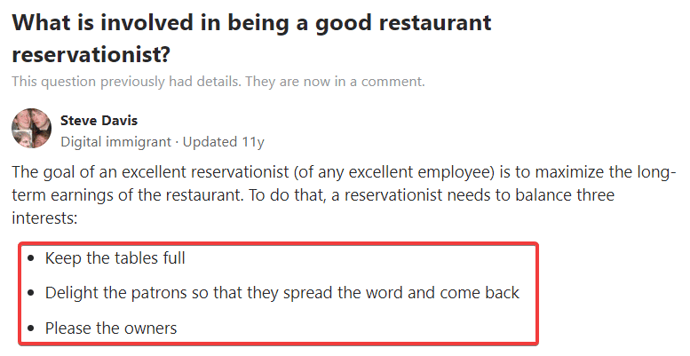
Source: Quora
The user goes on by saying that these goals are at odds with each other, and reservationists need to perform a balancing act.
They should strive to avoid overbooking but still try to keep tables full at all times and have an eye for maximizing profits each night.
Grappling with these tasks, they should master all details about reservation policies, including cancellation and no-show fees, the value of losing a table at different times of the day, and more.
For a more specific job description, check out this next job post by Fat Calf Brasserie.
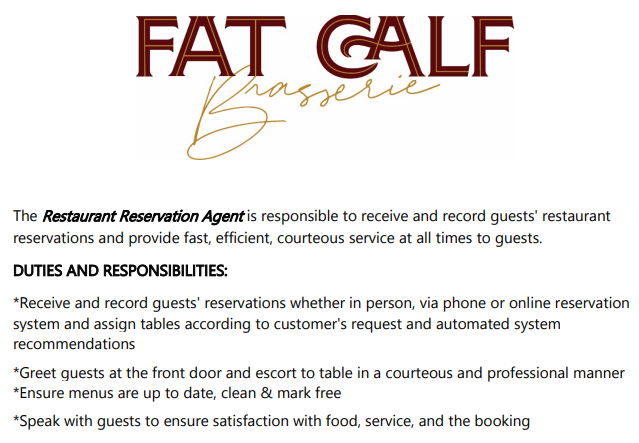
Source: Centenary
Whether you're hiring a dedicated reservationist or not, these responsibilities shouldn't be overlooked.
If a separate staff member for reservations is outside your agenda, appoint an employee to shoulder these responsibilities each night.
By delegating the various reservation management tasks to a single role, you can foster a more structured and productive reservation management process and enhance your team’s efficiency.
Take dining time into consideration
Time is a crucial factor while managing reservations, so our next tip can help you understand dining time and optimize operations.
Now, you might be wondering why dining time is so significant. Well, let's break it down.
Imagine a scenario where you've got a table booked back-to-back. The first guests are enjoying their meals and conversations, but they're taking their sweet time.
Meanwhile, the next reservation party is waiting impatiently at the door. Not a great situation, right?
For this reason, restaurants should track their dining times and optimize their reservations accordingly.
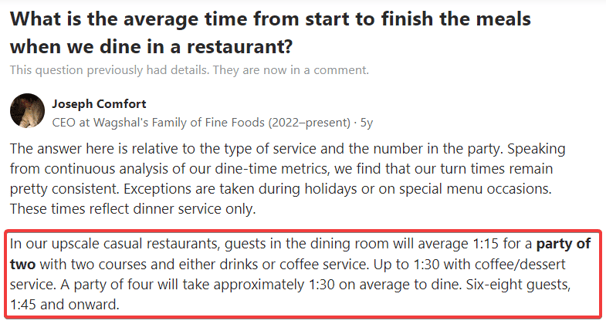
Source: Quora
As you can see in the above screenshot, this Quora user's establishment meticulously tracked average dining times based on the party sizes and the number of courses the guests planned on having.
You can follow their example and track the dining times at your restaurant.
After determining the average dining time, you can use this powerful information to book tables in a way so that there is little to no time between reservations where tables are left unoccupied.
You can even consider setting time limits for diners, after which they would be recommended to leave their table.
But tread lightly, as this policy can backfire and ruin your patrons’ dining experience.
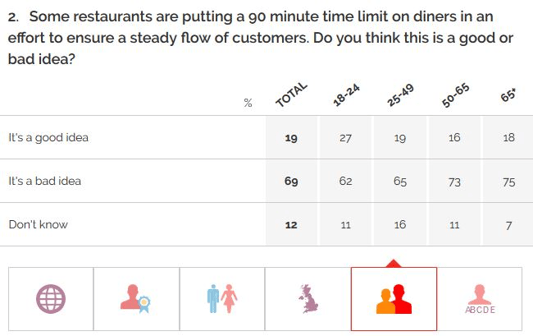
Source: Morning Advertiser
The survey above indicates that 69% of guests see a 90-minute time limit as a bad idea, with older diners being even more dissatisfied with this proposed policy.
And these results are to be expected. Customers come to a restaurant for a great and pleasant time and don’t like being rushed.
But you have a business to run, and long wait times are one common way a restaurant can lose money.
Balance is essential, so set a reasonable time limit to ensure guests have enough time to enjoy their meals while ensuring other guests aren’t waiting for a table for hours.
Have Policies in Place for Large Groups
Catering to larger groups can be a different ball game than smaller reservations, so having clear policies in place can help manage these types of reservations effectively.
If you think about it, large groups take up more space, require more attention, and generally take longer to serve.
These characteristics can pose a challenge when managing your restaurant's space and resources.
This is why even restaurants that don’t take standard reservations can have specific policies for large groups. Take The Wharf, for example.
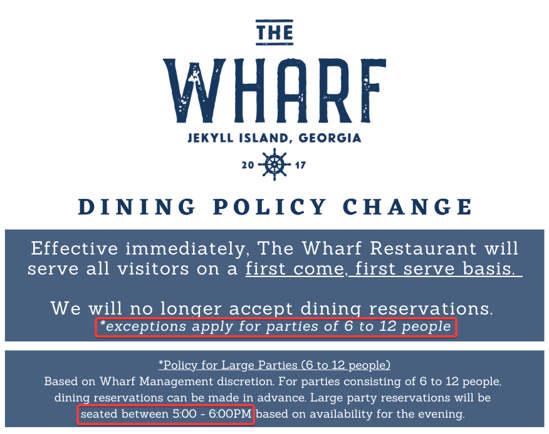
Source: Facebook
The policies shown above help The Wharf’s staff plan and manage their tables and resources during peak hours.
Note the seating time of 5-6 PM. That’s an example of a rule that is aimed at ensuring smooth restaurant operations.
Having a large group policy is great, but making sure your customers know about it is paramount.
Hence, your policy should be clearly visible on your website, social media platforms, and on the reservation section of your page.
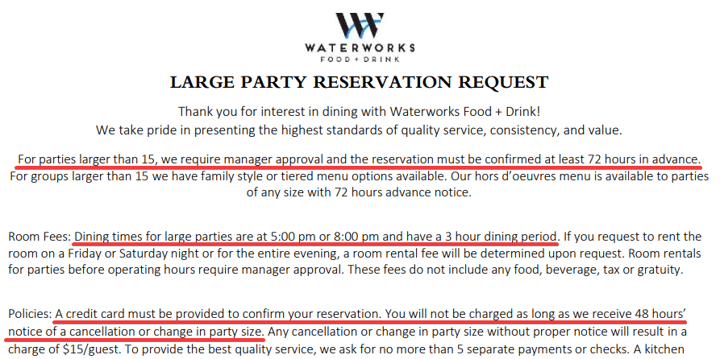
Source: Waterworks
The Waterworks restaurant, shown above, provides an excellent example.
They give detailed information about the reservation confirmation requirements, the dining times for large parties, and their cancellation and no-show fee policy, all on a readily accessible document on their site.
Having specific policies for large groups of diners can help streamline your operations and provide a better dining experience for all, so consider coming up with ones that work for your business.
Remind Customers of Their Reservations
Gently reminding guests of their reservations is a useful practice for making sure the guests show up on time for their bookings.
Everyone can sometimes make an impulsive restaurant reservation and, with everything else going on, quickly forget about their booking.
And that is where reminders and their many benefits come in.
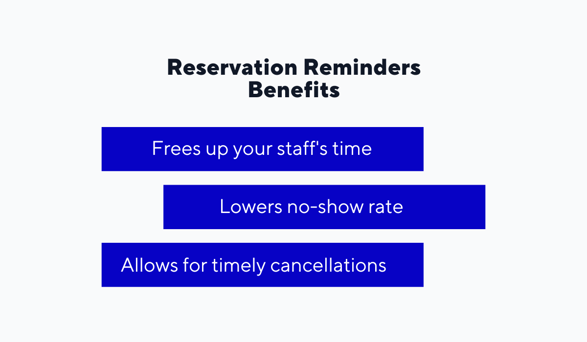
Source: Tablein
One significant advantage of alerts is that they can free up your staff’s time.
Instead of employees having to explain reservation details over phone calls, reminders can convey all the necessary information directly to the customers. Consider a simple SMS reminder like the one shown below.
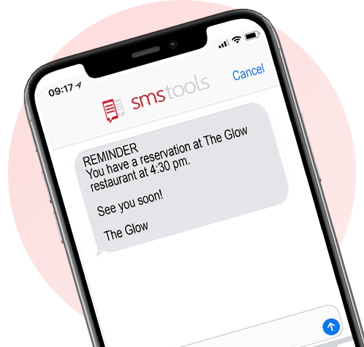
Source: Smstools
Such a reminder can be the difference between a full table or a no-show, thereby averting a potential loss of profit.
A customer can see this text, and if they can’t honor their booking, it might encourage them to cancel promptly, freeing up their table for others.
What’s great about these reminders is that they can be fully automated using a robust reservation tool. Consider the following image.
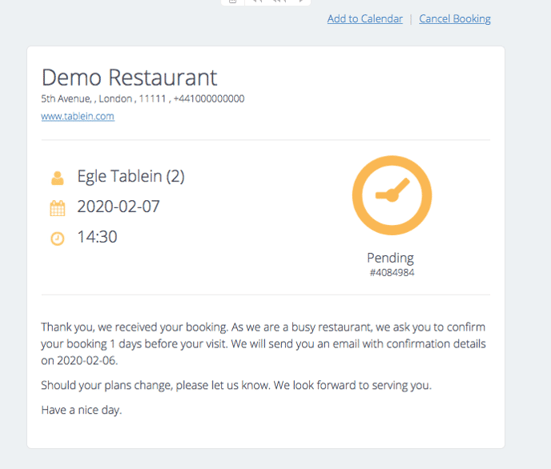
Source: Tablein
Customers can receive confirmation, cancellation, and reminder emails like the one shown above. And the best part?
You can customize when these emails are sent, giving you control over your reservation communications.
By setting up automated reservation reminders, you can reduce no-shows and ensure a steady flow of guests in your restaurant with little to no effort from your staff.
Limit How Long You Hold a Reservation
So, you’ve reminded your guests about their reservation, but how do you protect your business even further from late arrivals or guests who fail to show up for their table booking?
One effective way to do so is by limiting how long you hold a reservation.
Reservation holding limits are common practice, and for good reason.
Holding a table reservation for too long and waiting for customers who might ultimately not show up is bad for business.
After all, that table could have been filled with other customers during that time, and every minute of unoccupied table time impacts your bottom line.
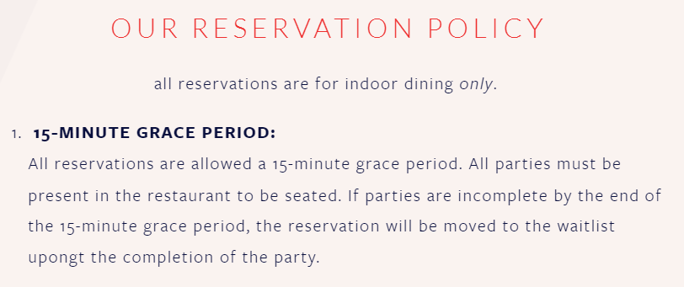
Source: ClawDaddy’s
Take a look at ClawDaddy’s policy above. A 15-minute grace period strikes a balance between customer courtesy and business efficiency.
This policy provides a buffer for unexpected delays and keeps the tables turning.
But there's more. As written in the reservation policy above, ensuring all party members are present before the grace period ends is also a good idea.
This way, you avoid the scenario where one person arrives on time, but the rest of the group trickles in slowly, increasing the time they occupy the table.
The Food&Wine blog writes about this topic, quoting a Manhattan Italian restaurant host who stated the following:
If that happens three times in a night and people were hanging out for 20 minutes each waiting for friends, I would have lost 60 minutes of business, which could be enough to flip a table.
Every minute counts in the restaurant industry, and a limit on how long you hold a reservation can be a great practice to increase table turnover and mitigate the loss of no-shows.
Charge a Fee to Discourage No-Shows
Speaking of no-shows, our final tip concerns implementing one more policy and certain fees to discourage guests from missing their reservations.
Why? Well, it's crucial because when a table is reserved, it's essentially blocked off for other potential guests.
If a guest fails to show up, that's a loss of potential revenue for the restaurant.
And these revenue losses can mount up, with missed reservations costing the restaurant industry around £17.6bn per year.
So, charging fees can discourage irresponsible or careless guests from becoming no-shows, as they will face costly consequences if they don’t take their bookings seriously.
Consider the following tweet:

Source: Twitter
As mentioned, Table Boston asks guests for their credit card information and charges a fee if guests fail to show up, or takes a considerable deposit for larger parties.
This approach provides a safety net for their profits and encourages guests to think twice before booking.
A reservation system can streamline this process for you, for example, by showing guests the days and times when deposits are required.
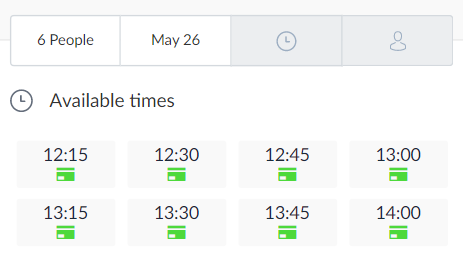
Source: Tablein
As shown in the image, a little credit card icon can inform guests that they will need to provide their credit card info if they want to make a reservation during these periods.
This simple visual cue can make them think twice before making an impulsive booking they might fail to honor.
To conclude, introducing a no-show fee not only discourages irresponsible booking behavior from guests but is a great way to additionally protect your business from potential losses in revenue.
Conclusion
Throughout this article, we've explored various strategies for managing restaurant reservations, including our suggestions about the tools, policies, and different practices you should consider using.We hope these tips have provided valuable insights into creating a seamless reservation experience for your customers and staff.
By implementing these recommendations, you can expect improved efficiency, enhanced customer satisfaction, and, ultimately, more successful restaurant operations.
Start off small, gradually introduce some of these changes to your reservation management practice, and tailor them to your specific needs and objectives.
So, go ahead and put the tips to work, and watch your restaurant flourish as you work on mastering the art of reservation management.
Get a 30-day Exclusive Trial
As a Tablein blog reader, you’re eligible for an exclusive 30-day free trial to experience our simple reservation solution for your restaurant.
Enter your business email, and we’ll send you all the steps needed to create your account.
Share this
You may also like

5 Reasons Why You Need a Restaurant Booking System

Taking Restaurant Reservations or Walk-Ins: Which Is Better?
